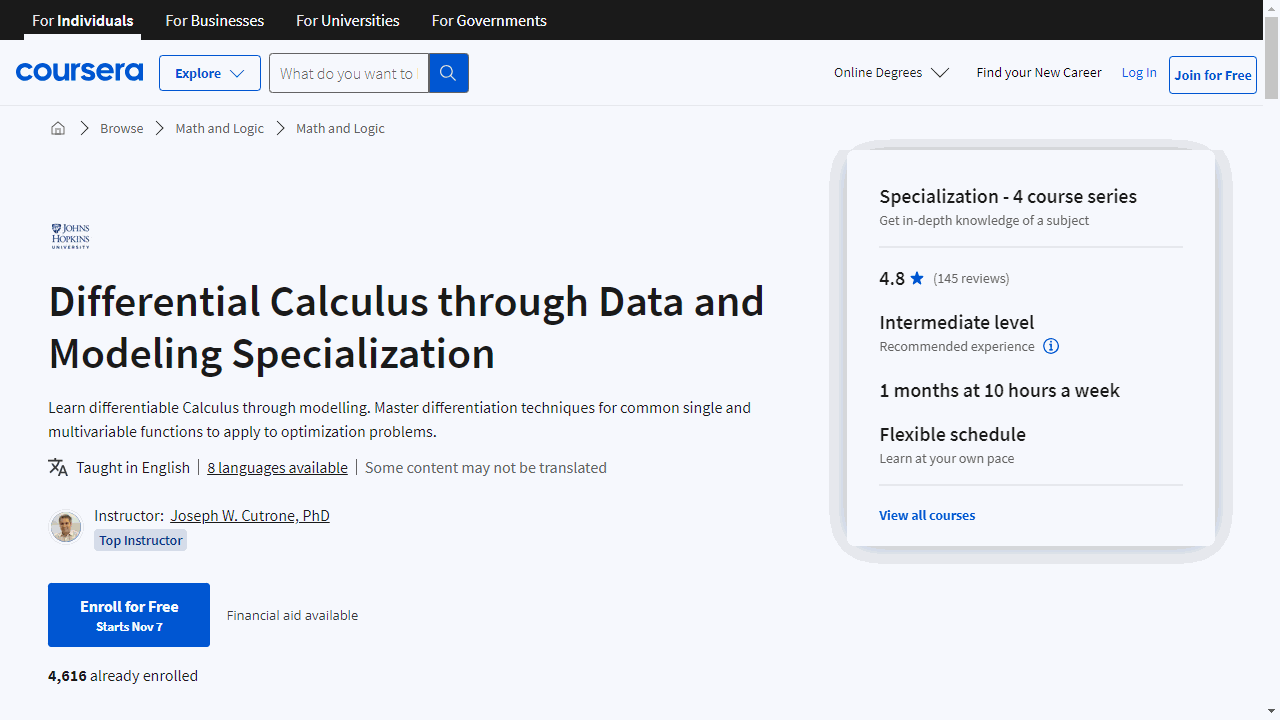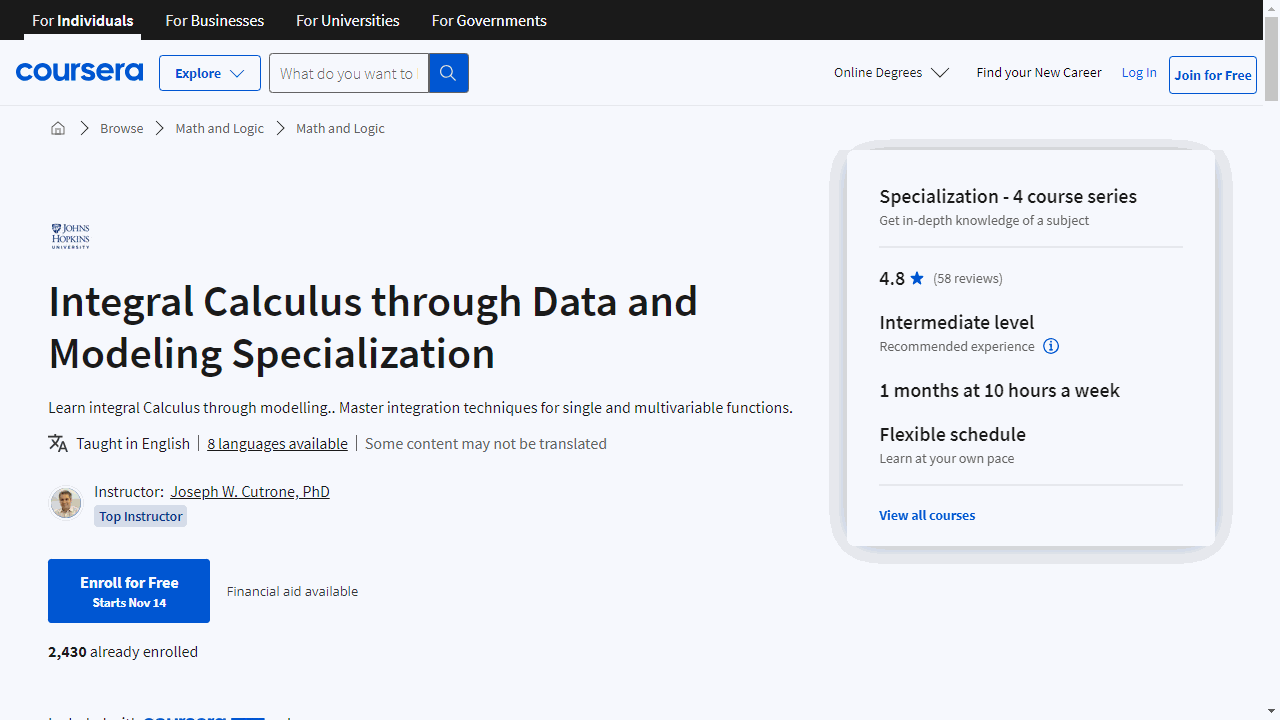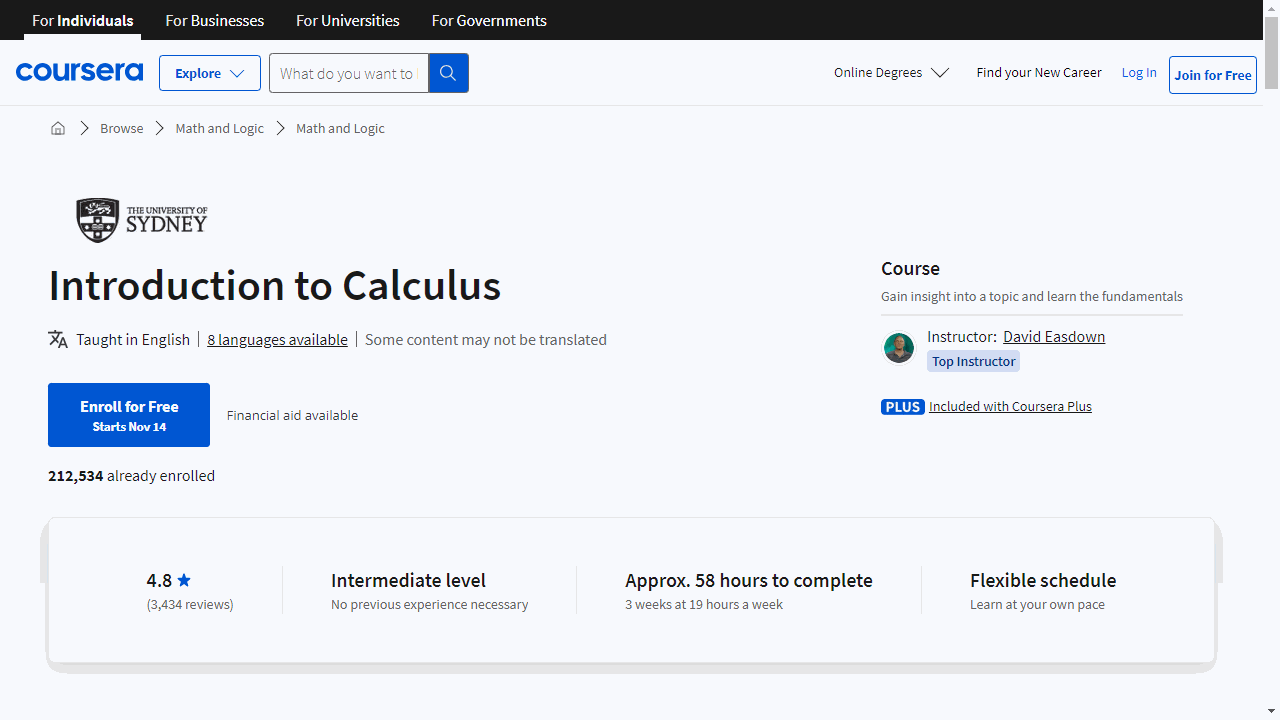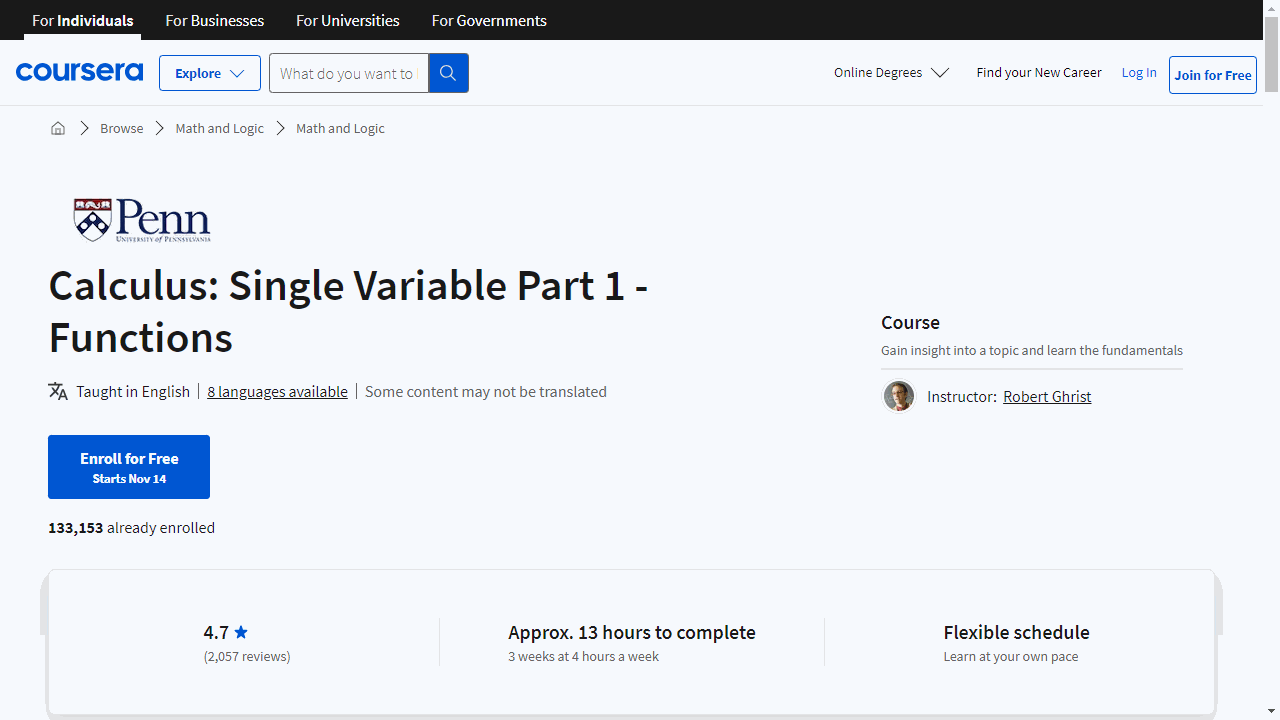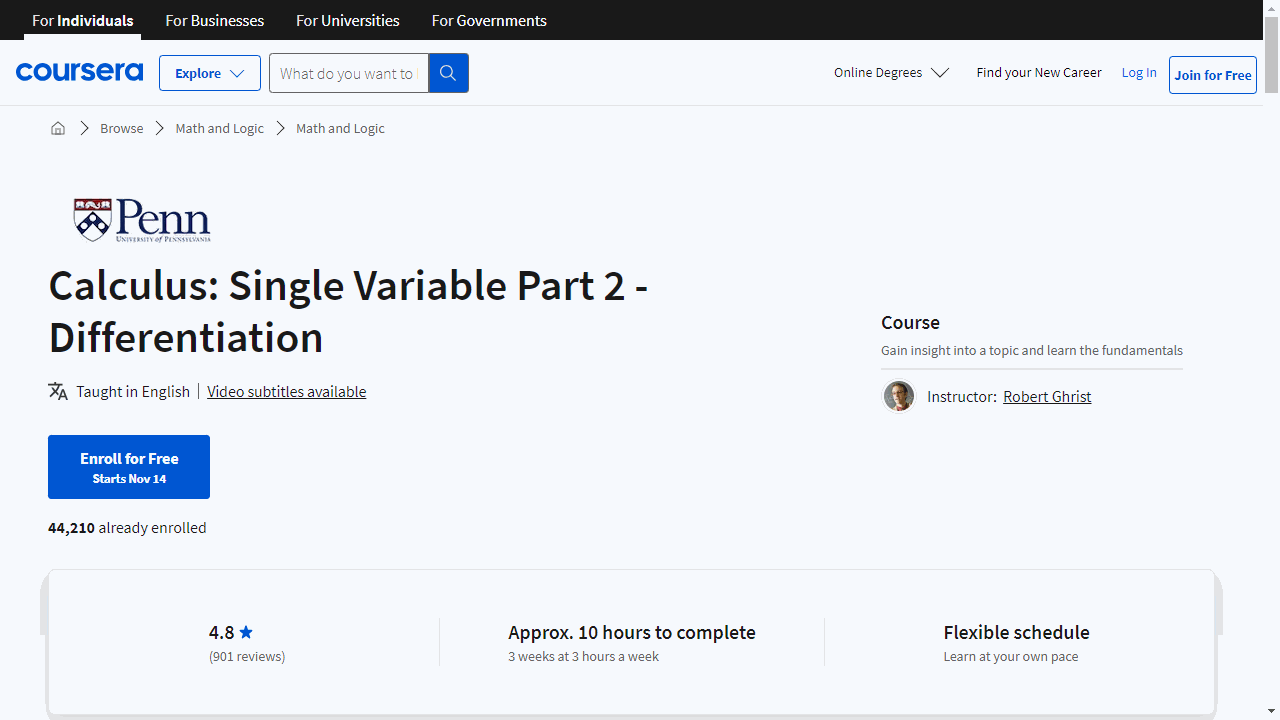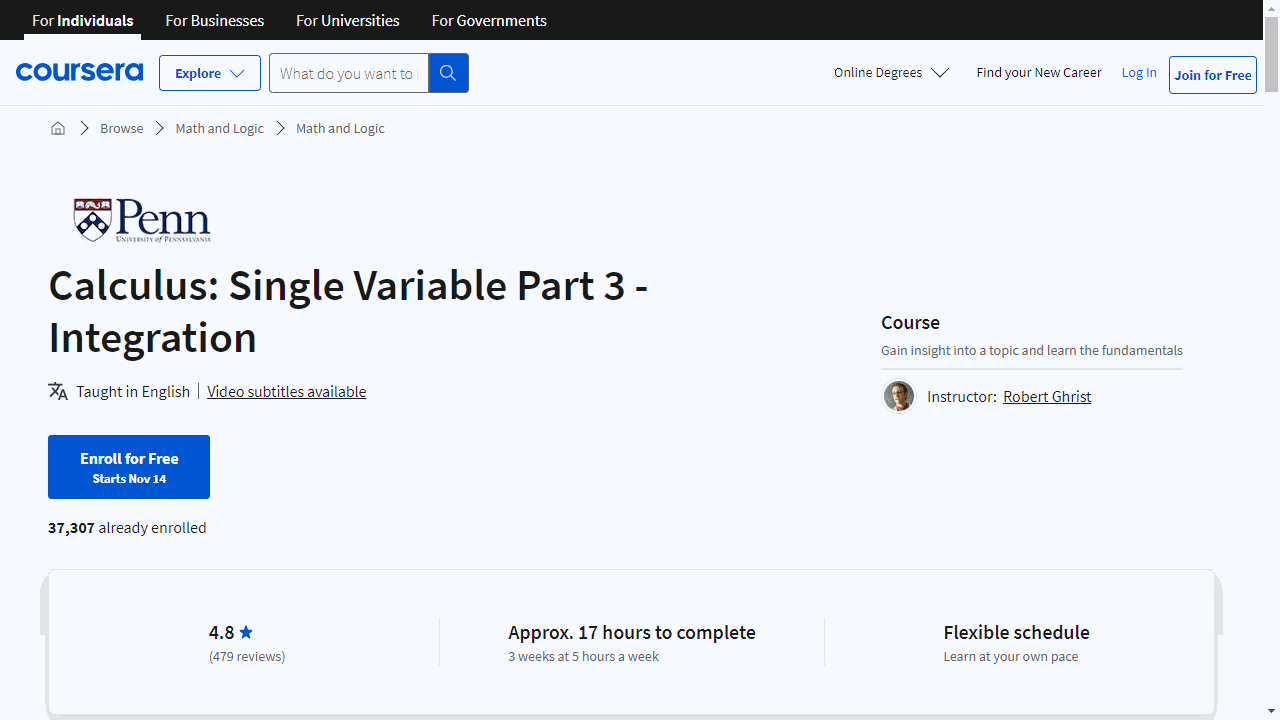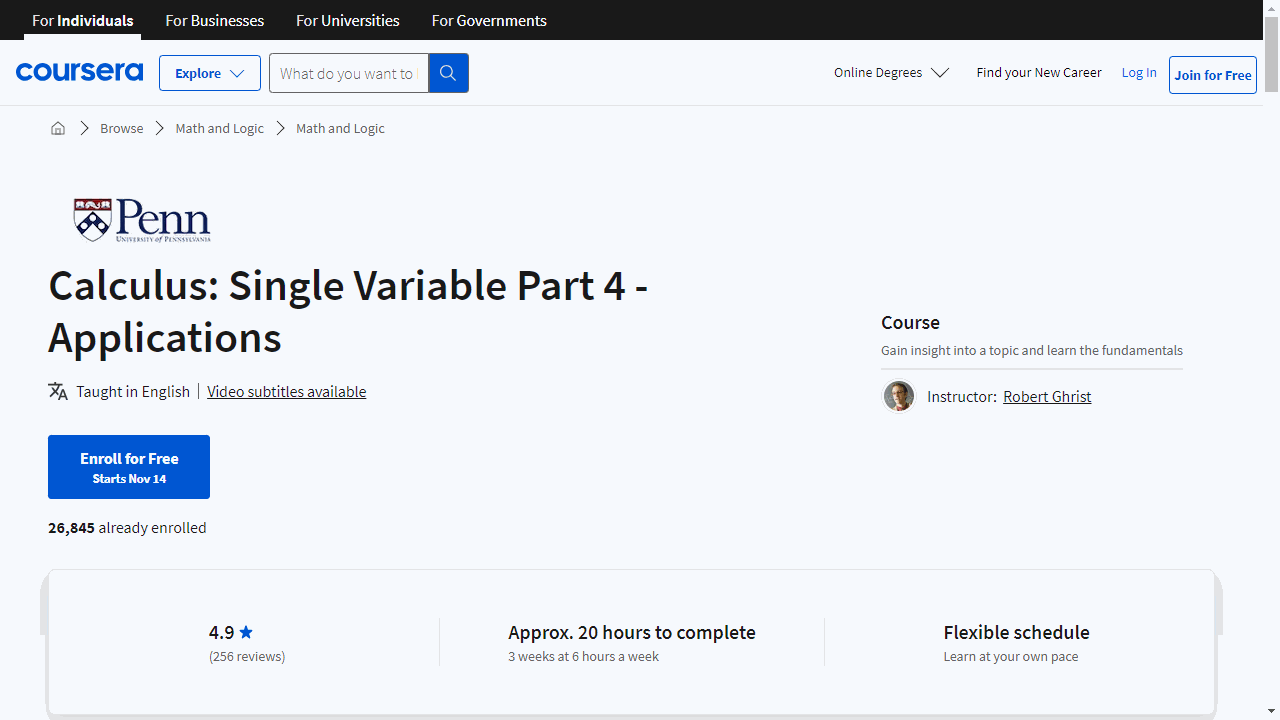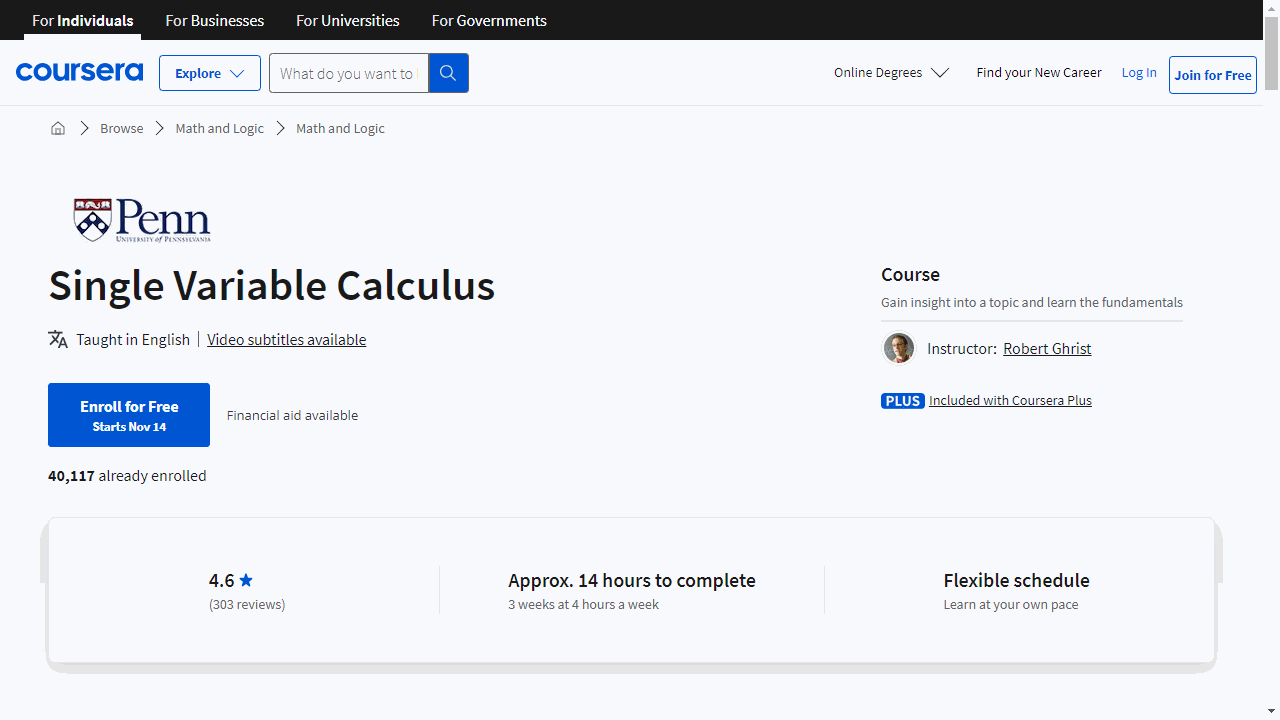Calculus is a fundamental branch of mathematics that explores the concepts of change and motion.
It’s essential for understanding various fields, including physics, engineering, economics, and data science.
Mastering calculus allows you to model real-world phenomena, analyze trends, and optimize solutions to complex problems.
Finding a good calculus course on Coursera can be overwhelming, with so many options to choose from.
You want a course that’s comprehensive, engaging, and taught by experts, but it also needs to be a good fit for your learning style and goals.
For the best calculus course overall, we recommend Differential Calculus through Data and Modeling Specialization.
This specialization stands out for its unique approach, blending theoretical calculus concepts with real-world data analysis.
It equips you with a solid understanding of calculus and demonstrates its practical applications in various professional contexts.
While this specialization is an excellent choice, we have other options for you depending on your specific needs and preferences.
Keep reading for more recommendations, including courses on integral calculus, applied calculus with Python, and beginner-friendly introductions to calculus.
Differential Calculus through Data and Modeling Specialization
If you’re searching for a comprehensive math course that seamlessly blends theoretical calculus with practical application, the “Differential Calculus through Data and Modeling Specialization” on Coursera is exactly what you need.
This series of courses is designed to not only build your mathematical foundation but also to demonstrate how these concepts are vital in analyzing real-world data.
Starting with “Calculus through Data & Modeling: Precalculus Review,” you’ll revisit essential functions, including polynomial and trigonometric, with a twist. The course emphasizes using these functions for data modeling, offering a more engaging approach to precalculus.
The integration of technology, such as graphing calculators and computer software, ensures that you’re learning with the tools that are used in actual data analysis.
As you progress to “Calculus through Data & Modeling: Limits & Derivatives,” the course introduces the concept of limits to define derivatives. This is where calculus begins to unveil its true potential, allowing you to understand how changes in one variable affect another - a fundamental skill in many scientific, financial, and engineering fields.
The journey continues with “Calculus through Data & Modeling: Differentiation Rules,” where you’ll learn shortcuts to finding derivatives.
This course simplifies complex calculations, making it easier to tackle a wide range of functions. By the end of this course, you’ll be equipped to solve problems involving rates of change and function approximation with confidence.
Lastly, “Calculus through Data & Modeling: Applying Differentiation” takes these concepts further by teaching you how to apply derivatives to graph analysis and optimization problems.
This course is particularly relevant as it touches on topics like machine learning and economic efficiency, showcasing the versatility of calculus in various professional contexts.
Each course in the Specialization builds on the last, ensuring a smooth transition from fundamental concepts to advanced applications. By the end, you’ll have a solid grasp of calculus principles and how they can be employed to interpret and solve real-world challenges.
Integral Calculus through Data and Modeling Specialization
This series of courses continues the journey that you began in the specialization on differential calculus.
It kicks off with “Calculus through Data & Modelling: Series and Integration.”
Here, you’ll delve into the concepts of series and integration—essential tools for understanding accumulation in various contexts, such as finance, demographics, and environmental science.
The course emphasizes the application of these mathematical concepts through projects that challenge you to analyze data and evaluate policies.
Moving forward, “Calculus through Data & Modelling: Techniques of Integration” expands your understanding of integrals, particularly when dealing with functions of multiple variables.
This course is crucial for those interested in complex systems and prepares you for the intricacies of vector calculus.
The inclusion of a peer-reviewed project ensures that you can apply these techniques to tangible problems, enhancing your learning experience.
In “Calculus through Data & Modelling: Integration Applications,” the focus shifts to the diverse applications of integration.
You’ll explore how integrals can be used to compute various quantities and derive formulas from Riemann sums.
The course also introduces the concept of the average value of a dataset, even when dealing with infinite values, and covers the computation of arclength, curvature, and areas between curves.
These skills are not only academically enriching but also highly applicable to numerous fields.
The final course, “Calculus through Data & Modelling: Vector Calculus,” brings you to the forefront of calculus applications.
You’ll study vector fields and learn about line integrals and Green’s Theorem, which are fundamental in understanding physical phenomena and solving spatial problems.
The course culminates with practical data analysis tools, equipping you with the knowledge to tackle advanced mathematical challenges.
Each course in the specialization builds on the previous one, ensuring a comprehensive understanding of integral calculus.
The real-world data and modeling approach not only makes the material more engaging but also demonstrates the relevance of calculus in various professional fields.
Applied Calculus with Python
If you find it easier to understand code than equations, this course is a great choice.
This course is unique because it blends traditional calculus concepts with practical Python programming, giving you a dual skill set that’s highly valuable in today’s tech-driven world.
I wish I had this course when I was first learning calculus!
Starting with an introduction to Python, the course ensures you’re not just passively learning; you’re actively engaging with the material by writing code from the get-go.
This approach helps cement your understanding of calculus as you apply it through programming.
As you progress, you’ll delve into SymPy, a Python library that simplifies symbolic mathematics.
This tool is a game-changer, allowing you to tackle complex calculus problems with ease.
You’ll learn to graph functions, create calculators, and more—all through the Python code you develop.
The theoretical foundations of calculus are thoroughly covered, from the basics of functions to the intricacies of derivatives and integrals.
But here’s where it gets interesting: you’ll immediately put theory into practice.
For example, after learning about limits, you’ll use Python to find them.
This isn’t just rote learning; it’s hands-on and practical.
Derivatives, the course’s cornerstone, are explored in depth.
You’ll understand their significance in finding max and min values and shaping graphs.
The course even guides you through building your own tools, like a local extrema calculator, reinforcing the concepts you’ve learned.
When it comes to application, the course shines with real-world examples.
You’ll tackle optimization problems and calculate areas under curves—essential skills for various applications.
Python steps in again to teach you both approximate and exact integration methods, a testament to the course’s commitment to practicality.
Introduction to Calculus
The course kicks off with the basics, like the real number line and decimals, ensuring you’re comfortable with the foundational elements.
You’ll also tackle the Pythagorean Theorem, which is more than just a theorem; it’s a stepping stone to understanding the nature of numbers, like the square root of 2.
As you progress, you’ll delve into algebraic expressions and surds, learning to handle equations and inequalities with confidence.
The course breaks down sign diagrams into two digestible parts, helping you to visualize solutions and understand intervals clearly.
Coordinate systems are up next, and you’ll get to grips with the geometry of lines and circles.
This isn’t just theory; it’s the groundwork for understanding shapes and spaces, which is crucial in calculus.
Module 2 introduces you to the curves of parabolas and the utility of the quadratic formula.
Functions are demystified as you explore their rules, domains, and ranges.
You’ll also encounter polynomial and power functions, and before you know it, you’ll be navigating the realms of exponential growth and basic trigonometry with ease.
In Module 3, the course shifts to motion and change, key themes in calculus.
You’ll explore slopes, rates of change, and the concept of limits.
The derivative is introduced as a limit, a fundamental idea in calculus, and you’ll learn to find derivatives from first principles.
Module 4 builds on your knowledge, teaching you how to analyze functions for their increasing or decreasing behavior and identify maxima and minima.
The course also introduces you to the Chain Rule, Product Rule, and Quotient Rule, essential tools for differentiation.
Finally, Module 5 ties everything together.
You’ll learn how to interpret the area under curves and understand the connection between areas and derivatives.
The course concludes with integration techniques, such as substitution, and explores applications like the logistic function, which has implications in various scientific fields.
Overall, this course is designed to be comprehensive without being overwhelming.
It’s a step-by-step journey through calculus, providing you with the tools and understanding you need to tackle more advanced topics or apply calculus in practical scenarios.
If you’re looking for a course that balances depth with clarity, this could be the right choice for you.
Calculus: Single Variable Part 1 - Functions
This course starts with an introduction to functions.
You’ll learn not just their definition, but also their significance in calculus.
Functions are the language of mathematics, and grasping them is crucial for your journey ahead.
Next, you’ll tackle exponentials.
These are not just about numbers getting bigger; they’re the key to understanding patterns of growth and decay in real-life scenarios.
The course makes this concept approachable, ensuring you can apply it to various problems.
Then comes a deep dive into Taylor Series.
This might seem intimidating at first, but the course breaks it down into understandable segments.
You’ll learn how to approximate complex functions with simple polynomials, a technique that’s incredibly useful in both theoretical and applied mathematics.
Computing Taylor Series is where theory meets practice.
You’ll get hands-on experience in calculating these series, reinforcing your understanding and preparing you for practical applications.
The concept of convergence is also covered.
It’s a fundamental idea that helps determine the behavior of sequences and series.
By understanding convergence, you’ll gain insights into the stability and long-term trends of mathematical functions.
Expansion Points are another critical topic.
The course teaches you how to choose the best point for expanding a function into a Taylor Series, enhancing the accuracy of your approximations.
Limits are the next stop on your calculus journey.
They’re essential for understanding the behavior of functions as they approach specific points or infinity.
The course simplifies this concept, making it accessible and less daunting.
You’ll also learn about l’Hôpital’s Rule, a handy tool for solving indeterminate forms.
This rule is a shortcut that can simplify complex limit problems, saving you time and effort.
Finally, Orders of Growth will be discussed.
This concept helps you compare the rates at which functions increase, providing a clearer picture of how different mathematical expressions behave as they grow.
Throughout the course, you’ll find bonus content that reinforces the main topics, offering you additional perspectives and examples to solidify your understanding.
Calculus: Single Variable Part 2 - Differentiation
This course is a continuation of the one above.
It’s designed to deepen your understanding of calculus through a focus on differentiation.
The journey begins with an in-depth look at derivatives.
This section isn’t just about learning the process; it’s about grasping the underlying principles that make derivatives tick.
By the end of this module, you’ll have a firm foundation that will support all your future calculus endeavors.
As you progress, you’ll encounter differentiation rules.
This is where the course shines, offering you a set of powerful tools to streamline the process of finding derivatives.
It’s like learning a new language in calculus, enabling you to express complex ideas more simply.
Linearization is introduced as a bonus topic, providing a practical application of derivatives.
This technique allows you to approximate functions using straight lines, simplifying the way you approach and solve calculus problems.
It’s a skill that will prove invaluable, especially when dealing with real-world scenarios.
The course doesn’t stop there.
Higher derivatives are also explored, giving you insight into the behavior of functions beyond the first derivative.
This knowledge is key to understanding the dynamics of changing systems, whether in physics, economics, or any field that relies on calculus.
Optimization is another critical area covered in the course.
Here, you’ll learn to apply calculus to find the most efficient solutions to various problems.
This module is about turning theory into practice, equipping you with the skills to make data-driven decisions.
Differentials and the differentiation operator are also part of the curriculum.
These concepts will help you understand and measure minute changes within functions, a skill that’s essential for precision in calculations and predictions.
It’s an excellent choice if you’re looking to build a robust understanding of calculus in a structured and engaging way.
Calculus: Single Variable Part 3 - Integration
After you learn to differentiate, it’s time to integrate.
This course is designed to deepen your understanding of integration, a key concept in calculus that’s essential for a variety of applications.
The journey begins with indefinite integrals, the fundamental pieces you’ll use to calculate areas under curves.
It’s a crucial skill that sets the stage for more advanced topics.
Next, you’ll tackle Ordinary Differential Equations (O.D.E.s).
These equations are vital in describing how things change over time and you’ll learn the techniques to solve them.
This isn’t just theoretical knowledge; it’s the kind of stuff that’s used in real-world scenarios, from physics to engineering.
You’ll explore linearization of O.D.E.s, which simplifies complicated systems, making them more manageable.
It’s a valuable skill that can be applied in various scientific fields.
As you progress, you’ll encounter several bonus sections that introduce advanced integration techniques.
Integration by substitution will help you transform difficult integrals into simpler forms.
Integration by parts is another powerful tool you’ll learn, enabling you to break down complex expressions.
When trigonometric functions are involved, trig substitution will be your guide, simplifying integrals that might otherwise seem daunting.
And with partial fractions, you’ll learn to decompose complex fractions into simpler parts that are much easier to integrate.
The course also covers definite integrals and the Fundamental Theorem of Calculus, which is the link between differentiation and integration.
This theorem is a pivotal concept that will enhance your understanding of how calculus works.
Improper integrals are also part of the curriculum, teaching you how to handle integrals with infinite limits or discontinuous integrands.
Lastly, you’ll discover how to use trigonometric integrals, tables, and software to solve integrals more efficiently.
This practical knowledge equips you with the tools to tackle integrals both by hand and with technology.
Calculus: Single Variable Part 4 - Applications
After learning how calculus works, it’s time to see how they apply to everyday scenarios.
Starting with areas, you’ll learn to calculate both simple and complex shapes.
This isn’t just theoretical knowledge; it’s the kind of skill you can use to plan a landscaping project or design a piece of art.
The course includes bonus content to solidify your understanding, ensuring you’re well-prepared for more challenging problems.
When it comes to three-dimensional objects, the Volumes section has you covered.
You’ll discover how to determine the capacity of various containers, which is essential knowledge for fields ranging from engineering to interior design.
The bonus sections on complex volumes push you to apply these concepts in more intricate situations.
Understanding dimensions is crucial, and the course guides you through the relationship between volume and dimension.
This part of the syllabus helps you grasp how scaling affects volume, a concept with applications in manufacturing and modeling.
Arclength and Surface Area are next, teaching you to measure curves and cover surfaces efficiently.
Whether you’re interested in architecture or fashion design, these skills are invaluable.
The course ensures you can handle both the calculations and the practical implications.
The Work section translates force and movement into mathematical terms.
This is essential for anyone interested in physics or engineering, as it relates directly to understanding how much energy is required for various tasks.
With Elements, Averages, and Centroids, the course brings you back to foundational concepts that underpin all the applications you’re learning.
These sections are about finding balance and symmetry, which are key to product design and even art.
Moments and Gyrations introduce you to the stability of objects, a concept that’s particularly relevant if you’re curious about how things stand up or stay put.
It’s a less commonly taught aspect of calculus that can give you an edge in understanding structural integrity.
Finally, the course rounds out with a practical approach to probability.
You’ll explore Fair Probability, Probability Densities, Expectation, and Variance, giving you a solid foundation in predicting outcomes and understanding data, which is crucial in fields like economics and data science.
Single Variable Calculus
This course is designed to build your understanding step by step, starting with sequences.
As you progress, you’ll tackle differences and discrete calculus.
When you get to numerical O.D.E.s and numerical integration, you’ll see how calculus isn’t just about theory.
You’ll use computers to solve equations that are too intricate for traditional methods, bridging the gap between abstract concepts and practical applications.
The course then guides you through infinite series and convergence tests.
This is where your problem-solving abilities really start to shine.
You’ll learn to sum infinite numbers and determine when these sums are meaningful, sharpening your analytical skills.
Power series and Taylor series are next, and they’re game-changers.
These topics allow you to approximate complex functions with simple ones, giving you a powerful tool for analysis.
Understanding approximation and error is essential, and this course covers it with the right balance of depth and clarity.
You’ll learn to gauge the accuracy of your approximations, ensuring that your mathematical predictions are reliable.
As you near the end, the course revisits key concepts with additional bonus content.
This reinforces your learning and integrates the various topics, ensuring you have a cohesive understanding of calculus.
The course concludes with a section on foreshadowing, setting the stage for further exploration in calculus.
It leaves you prepared and excited for what’s to come, whether in more advanced courses or real-world applications.
Also check our posts on:
